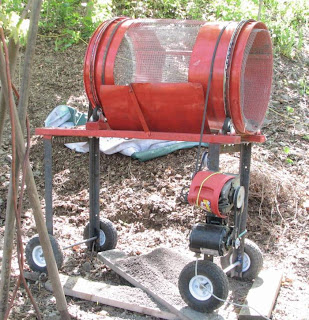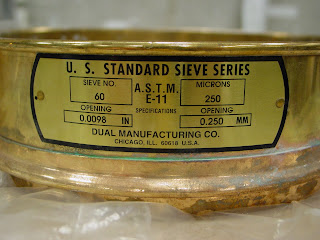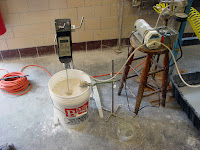What happens to unused material after I am done printing a build? I simply scoop it from the build and overflow bin back into the feed chamber, right? Well, not exactly. There’s a good chance that there are fragments of solidified material in there which I certainly don’t want going into my next build cycle. These fragments include broken parts and small parts that get lost during de-powdering from the printer. Also, I often find agglomerations of material after screening material that has previously been screened. These agglomerations are not remnants from the printing process-they really just look like nondescript small chunks of "stuff". I think they are due to humidity in the air which slowly activates the powder.
I developed a vibratory screener to purify material after printing. I originally performed this operation by hand using a sieve. I found that doing this by hand was tiring, slow and messy. Over time this system was developed. As with many projects, I often start by looking at precedents. I really enjoy being a tourist in different fields, trying to understand why things are designed a certain way before deciding how I will precede. The following were things I looked at for inspiration…
The above designs classify material into two or more sizes. Material larger than the screen is removed, which keeps the screen clear and allows for continuous operation. While that is a nice feature, it also requires a fair bit of engineering, footprint and investment in equipment. I decided to stick with a periodic system (i.e. one that would need to be stopped regularly for cleaning).
Another consideration was how to deal with screen clogging. Below a certain size, materials that are close in diameter to the mesh opening have a tendency to clog the screen. Solutions to this include vibrating the screen at higher frequencies or using anti-blinding balls as seen here…
The balls bounce upward against the screen (thanks to the vibrations of the system), hitting the screen on a regular basis. The balls are made of rubber to reduce wear on the screen. I chose to solve the issue of binding by choosing a large enough screen so that clogging wasn’t an issue. This was done through trial and error, and no doubt will change as the material size of new powders varies.
My system is based on relatively accessible materials:
• 5 gallon bucket
• Brass screen (60 mesh; 8” diameter)
• Vibrator motor
• Wood and screws
• Wood and screws
• 4 springs
Bottom part (left) has a routed groove which accepts the rim of the bucket. Top part is shown on the right.
Setting things up: Place the machine over top of the bucket; place a plastic bag inside the bucket through the opening; press the screen into the opening, creating a seal between the plastic and the opening.
Progress during screening.
5 gallons of recycled powder, ready for printing!
This system worked surprisingly well for a prototype! It takes about a half hour to fill a 5 gallon bucket with material. If I were to build this again, I would re-design the location of the motor, as it does get in the way of access to the screen. Also, all that extra wood represents extra mass that the motor must move. It essentially robs the screen of that energy. Instead, I would locate the motor on the top horizontal wood piece, right next to the screen. This would probably require a second identical motor to balance the weight so that the screen could sit horizontally. I would also think about a hopper to allow for more automated use.
I've posted a video of this in action here...

















































